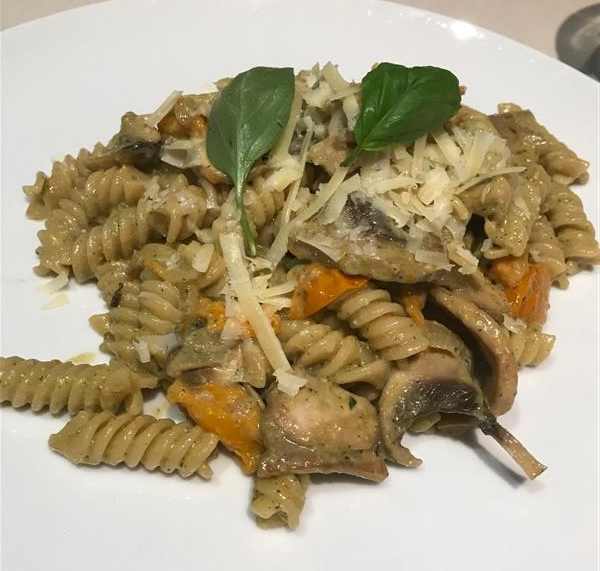Homemade Basil Pesto Recipe
There’s nothing better or more satisfying than making basil pesto from scratch. Not only does it taste delicious, it’s also really quick and simple to make. Whether you have a basil plant growing in your herb garden or balcony or buy fresh basil from the shops, once you make fresh basil, you’ll never want to buy jar pesto ever again. Plus, I love that for every basil leaf you take, two more basil leaves grow back in its place – it’s a plant that keeps on giving, making this dish affordable and accessible as long as you care for your plant.
What can you use basil pesto for?
Basil pesto is commonly used in Italian pasta dishes, but it also tastes delicious as a sauce for meat, fish and vegetables. Try spreading it over grilled salmon or lamb chops, garnish your vegetables or mix into a salad dressing. You could also use it as a pizza topping or as a pizza sauce, spread it on sandwiches, add it to eggs, use it as a dip or as a topping for a baked sweet potato. The recipe ideas are endless.
Is basil pesto healthy?
Basil pesto is a healthy and nourishing recipe, especially when you make it fresh as you know exactly what you put into it. Firstly, basil is packed full of essential vitamins, minerals and antioxidants including vitamin A, C, K and manganese. It is also a good source of calcium iron, folate, copper and omega-3 fatty acids. The recipe also uses olive oil and pine nuts, which although are high in calories, they contain these essential fatty acids. This unsaturated fat can help decrease inflammation and improve cholesterol and can also reduce your risk of diabetes, cancer and heart disease. Parmesan cheese is also high in calcium and a good source of protein, but low in fat as well as being a low-lactose food. However, like all things in life, it’s important to eat pesto in moderation.
How long will basil pesto keep in the fridge?
Whenever I make pesto, I like to use it straight away. However, if you make a large batch or want to make it ahead, fresh homemade basil pesto can be kept in the fridge for up to a week. I recommend storing it in a tightly sealed santised jar if possible. You can also freeze pesto in small sealable tubs or in an ice cube tray or mold. Once the cubes are frozen, empty the cubes into a freezer bag to store until required.
What equipment is required to make basil pesto?
You can easily make basil pesto with just a few pieces of kitchen equipment.
- An oven and baking tray for toasting the pine nuts (or you can do this in a frying pan on the stove)
- A food processor or blender to blend the ingredients
- A knife for cutting the garlic
- Cheese grater
If you don’t have a food processor or blender don’t despair. You can still make basil pesto by using a knife and chopping the ingredients by hand and using a pestle and mortar to grind it together. Just bear in mind it will take longer, but you will be rewarded by the smells of fresh basil and garlic.
Homemade Basil Pesto | Serves 4 | Easy | 30 minutes
Ingredients
- 50g pine nuts
- 2 cups fresh basil, washed
- 2 garlic cloves, halved
- 60g parmesan cheese, grated
- 5 tablespoons extra-virgin olive oil
- 1 tablespoon lemon juice
- ½ teaspoon fine sea salt
Method
- Preheat oven to 180°C. Spread the pine nuts over a baking tray in a single layer and bake in the oven for 5 minutes or until toasted, but not burnt. Remove from the oven and set aside for 10 minutes to cool.
- Add the pine nuts, basil, garlic, parmesan, lemon juice and salt into a food processor or blender. Process the ingredients until finely chopped. With the machine still running, gradually drizzle in the olive oil until the mixture is well blended.
- Taste the pesto with a teaspoon and modify to your preference. Add more Parmesan for creaminess, or a pinch of salt if it tastes too bitter. If you like your pesto smoother and thinner, consider adding in more olive oil. Note: if using with pasta, the pesto can be thinned out with the pasta cooking water.
- Use immediately or store in the refrigerator for up to one week.
- If using for pasta, drain the pasta into a colander over a measuring cup to catch the pasta cooking water. The starch from the pasta helps make your pasta saucy creamy and coats the pasta evenly. Toss your pasta off the heat with the basil pesto and a small amount of the pasta cooking water. You can add more water if you want a thinner consistency, but do this slowly so it’s not too wet.
Alternative Pesto Ingredients
Making basil pesto can be expensive. For a more affordable recipe, consider the following:
- Swap out the pine nuts for cashew nuts
- Add in spinach to make your pesto a brighter green and a less intense basil taste if you’re not a big fan
- Parmesan cheese – you can also use Pecorino Romano for a creamier and cheesier flavour. If you’re vegan, use a non-dairy cheese or add 2 to 3 tablespoons of nutritional yeast.
